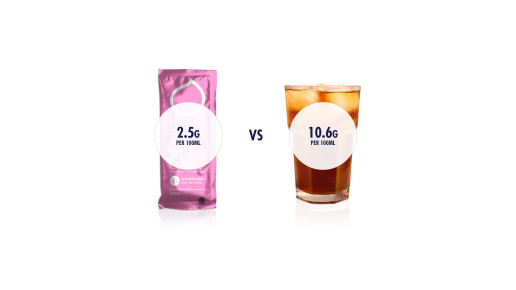Developed by Australian Obstetrician Dr Rob Buist for Bump and Beyond
In 2014 Sydney obstetrician Dr Rob Buist became frustrated by the absence of a healthy hydration product specifically formulated for pregnant women, women in labour and those who are breastfeeding.
The importance of hydration in pregnancy and birth has long been recognised, but many beverages available may contain either high levels of sugar, an inappropriate amount of sodium, or artificial ingredients that may not be appropriate in pregnancy.
Rob decided to close this gap in the market by inventing a hydration beverage ideal for supporting the hydration of pregnant and breastfeeding women.
He developed aquamamma® – A beverage that is low in calories, low in sugar and contains natural colours and flavours.
Aquamamma® and pregnancy
Nutrition in Pregnancy
Experts recommend that the dietary energy requirements for non-pregnant women should range between around 8,000 and 10,000 kilojoules (kJ) per day. The variation in these figures is accounted for by different levels of physical activity. The additional energy requirements for pregnancy are:
- First trimester: no additional requirement (the baby is still tiny)
- Second trimester: additional 1,400 kJ per day.
- Third trimester: additional 1,900 kJ per day.
Women often ask about what is the normal expected weight gain in pregnancy. It is important to remember that most of your weight gain is comprised of extra blood (3 kg), your baby (3 to 4 kg), the placenta (500 g), and the amniotic fluid (500g). Your goals for total weight gain in pregnancy depend upon your pre-pregnancy BMI as follows:
BMI at the time of conception: Total pregnancy weight gain goal (singleton pregnancy):
| BMI | Target |
| 18.5 – 24.9 | 11.5 – 16 kg |
| 25 – 29 (overweight) | 7.5 – 11.5 kg |
| 30 or more (obese) | 5 – 9 kg |
You can see that the higher your BMI, the less weight you should gain over the course of your pregnancy. Remember to speak with your healthcare professional if you are concerned.
Experts recommend that you attempt to consume a low fat, low carb diet in pregnancy. You should enjoy a variety of nutritious foods from the following food groups every day:
- Vegetables and legumes / beans
- Fruit
- Grains and cereals
- Lean meats and other proteins such as cooked eggs
- Milk and other – reduced fat – dairy products
It is best to limit your intake of foods containing saturated fat, added salt and sugar. You should avoid soft drinks, cordials, fruit juices, energy and sports drinks that are high in sugar.
Aquamamma® is low in sugar, low in kilojoules / calories and low in sodium. A 450 mL bottle of Aquamamma® contains only 212 kJ so it can be incorporated into a healthy pregnancy diet.
Hydration in Pregnancy
Somewhere between 50 and 80 percent of our bodies are comprised of water. Beginning at 6 to 8 weeks gestation your total body water increases by 8 to 9 litres in pregnancy. Pregnant women require more fluid intake for their increased blood volume (up by fifty percent), the needs of the developing baby and the amniotic fluid. Every woman that has ever been pregnant knows you pass a lot of urine frequently in pregnancy. Your urine output increases significantly as do your insensible losses (fluid lost through sweating and breathing) when you are pregnant.
These changes mean that pregnant women have to consume more fluid than those who are not pregnant. Experts recommend that the appropriate fluid intake for pregnant women is 2.3 to 3 litres per day, although this amount will increase with vomiting, exercise and during labour.
Exercise in Pregnancy
It is important to be active before conception, throughout pregnancy and after you have given birth. Exercise helps reduce some common symptoms of pregnancy (backache, constipation, bloating and swelling) as well as increasing your energy, improving your mood and improving your posture.
Aim for at least thirty minutes of moderate exercise per day at least four days per week. The term “moderate” obviously varies for different women, but the best guide is that your heart rate should rise and you should start sweating but still be able to talk normally whilst exercising. Make sure you warm up and stretch prior to exercising and cool down afterwards.
Your ability to exercise will be influenced by your level of fitness and your usual exercise regime prior to pregnancy. For example regular runners should be able to continue running – with some modifications – until the third trimester. Really strenuous exercise, skiing, contact sports and scuba diving are unsafe in pregnancy.
Don’t exercise in unduly hot or humid conditions and make sure you wear appropriate clothing (including a well-fitting bra). You must stop exercising if you become breathless or fatigued.
Hydration is critically important when you are exercising in pregnancy. Experts recommend women consume 2.3 to 3 litres of fluid per day but this amount will increase with exercise. Aquamamma® has a low sugar and low sodium content making it a much healthier alternative to fruit juice, smoothies, soft drinks and sports drinks that are high in sugar.
Great forms of exercise during pregnancy include walking, swimming, water aerobics, using a cross trainer and an exercise bike. Improving your core strength by doing Pilates and / or Yoga may also help to reduce the pain associated with separation of your pelvic bones in pregnancy.
It is important to talk to your health care provider about exercise in pregnancy, especially if you have any medical problems or pregnancy complications.
Labour
Exercising regularly, eating healthy and attending prenatal birthing classes are really good ways to prepare yourself (and your partner) for labour.
The significant demands of labour might lead you to believe that sports drinks or an oral rehydration solution might be the best drinks to consume in labour because of their high sugar and / or sodium (salt) contents. This is not so. These products are designed for specific situations – athletes using up thousands of kilojoules daily with training (sports drinks) and people with significant diarrhoea, with or without vomiting (oral rehydration solutions).
Accordingly we believe that Aquamamma® is an ideal beverage to support hydration for when you’re in labour as it is low in sugar and sodium (salt).
Aquamamma® and breastfeeding
Hydration and Breastfeeding
During breastfeeding mothers experience an increased water loss via breastmilk of approximately 700mL per day. Water accounts for 87% of breastmilk and the average milk production in the first six months of breastfeeding is 780mL per day. This is why experts recommend the adequate intake of fluid for breastfeeding women is up to 3.8 litres per day.
Obviously your need for hydration will increase further when you are exercising. Aquamamma® is designed for the hydration needs of breastfeeding mothers and is healthier than:
- Sports drinks
- Oral Rehydration Solutions
- Fruit juices that are high in sugar
- Soft drinks, and
- Energy drinks
Exercise and Breastfeeding
Most women are really keen to get back into their usual (i.e. non pregnant) exercise programme especially if they are keen to shed any extra kilograms they have gained during their pregnancy. Aside from assisting with weight loss, exercise has a number of other benefits for new mothers:
- It helps strengthen and tone your abdominal muscles which may have been stretched and / or separated during your pregnancy and birth
- It boosts energy
- It promotes better sleep and may relieve stress
You should try to aim for at least 30 minutes of exercise that is at least moderate intensity (see “Exercise in Pregnancy”) at least four days per week.
If you have had a healthy pregnancy and a normal birth you can start slowly exercising again soon after the birth of your baby – a few days after the birth or as soon as you feel ready. If you had a complicated pregnancy and / or a complicated birth (including by caesarean) you should ask your health care provider when to start exercising again.
If you conducted vigorous intensity exercise prior to your pregnancy then it is fine to return to such exercise after birth as long as your health care provider agrees. Running, “spin” classes and swimming laps are good examples of vigorous intensity exercise.
Muscle strengthening exercises are also important after the birth of your baby. These range from mild (Pilates and yoga) to moderate (sit ups, push ups and “planking”) to intense (lifting weights or exercises or classes incorporating weights). You should avoid these types of exercises for six weeks following a caesarean birth. And – you guessed it – check with your health care provider when considering muscle strengthening exercises after birth.
Don’t forget the importance of pelvic floor exercises after you have given birth. Even if you did not experience labour (i.e. gave birth by a caesarean without experiencing labour) your pelvic floor muscles will have been affected by your pregnancy hormones and the weight of your baby (or babies!). A visit to a dedicated Women’s Health Physiotherapist for pelvic floor advice is a really good idea.
Sugar Content Comparison
*Approximate values.








